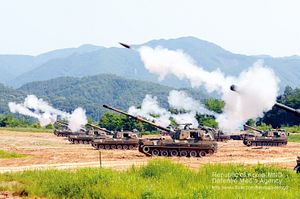On Thursday, the South Korean army held its largest-ever artillery drills. The live-fire exercise involved around 300 artillery systems.
According to an account of the exercise given to the Associated Press by a South Korean army official, “units along the border began firing shells simultaneously in multiple directions on Thursday afternoon.”
The exercise did not draw any reaction, military or otherwise, from North Korea, which has been known to react angrily to exercises on the southern side of the tense border between the two Koreas.
The unusually large size of the South Korean artillery drill and the lack of a North Korean response are striking; live-fire drills are a regular occurrence in South Korea and invite swift reactions from North Korea.
South Korea has a large arsenal of self-propelled, field, and rocket artillery, including 105 mm and 155 mm towed howitzers, 105 mm and155 mm self-propelled howitzers, 81 mm and 107 mm self-propelled mortars, and several multiple launch rocket systems (MLRS) and multiple rocket launchers (MRL).
Last year, as The Diplomat reported, the two Koreas exchanged artillery fire, with no reported casualties on either side.
The exchange started as North Korea fired a 14.5 mm shell into Yeoncheon county in South Korea’s Gyeonggi Province, northwest of Seoul.
The artillery exchanges came amid increased brinkmanship between the two neighbors as Pyongyang strongly protested South Korea’s deployment of a propaganda loudspeaker near the border. South Korea evacuated residents of Yeoncheon county in response to last year’s artillery exchange.
As last summer’s artillery exchanges intensified, North Korea announced a “quasi-state of war.”
In 2010, North Korea fired around 170 artillery shells at Yeonpyeong Island, causing considerable damage to civilian and military targets. Both Koreas endured casualties in the exchange, which came seven months after the sinking of the ROKS Cheonan by a North Korean submarine.
United Nations Secretary-General Ban Ki-moon had described the 2010 artillery exchange at Yeonpyeong as “one of the gravest incidents since the end of the Korean War.”

































